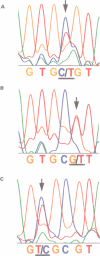Abstract
The WT1 gene, one of the genes responsible for Wilms tumour, is thought to play a crucial role in the development of the kidneys and gonads. This gene encodes four protein isoforms resulting from two alternative splicing sites, one of which involves inclusion or exclusion of lysine, threonine, and serine (KTS) between the third and fourth zinc finger domains. WT1 is virtually always mutationally inactivated in patients with Denys-Drash syndrome. We analysed WT1 in eight patients who had been diagnosed as having this syndrome, and identified five previously unknown mutations affecting splicing donor sites of intron 9. These mutations affect alternative splicing. The isoforms retaining KTS are not produced. The clinical features of the patients with these intronic mutations were consistent with those of Frasier syndrome, characterised by a more slowly progressive nephropathy than Denys-Drash syndrome, associated streak gonads, and no Wilms tumour development. Our results indicate that WT1 isoforms, including/excluding KTS, have different functions in tumorigenesis and organogenesis of the kidneys and gonads.
Full text
PDF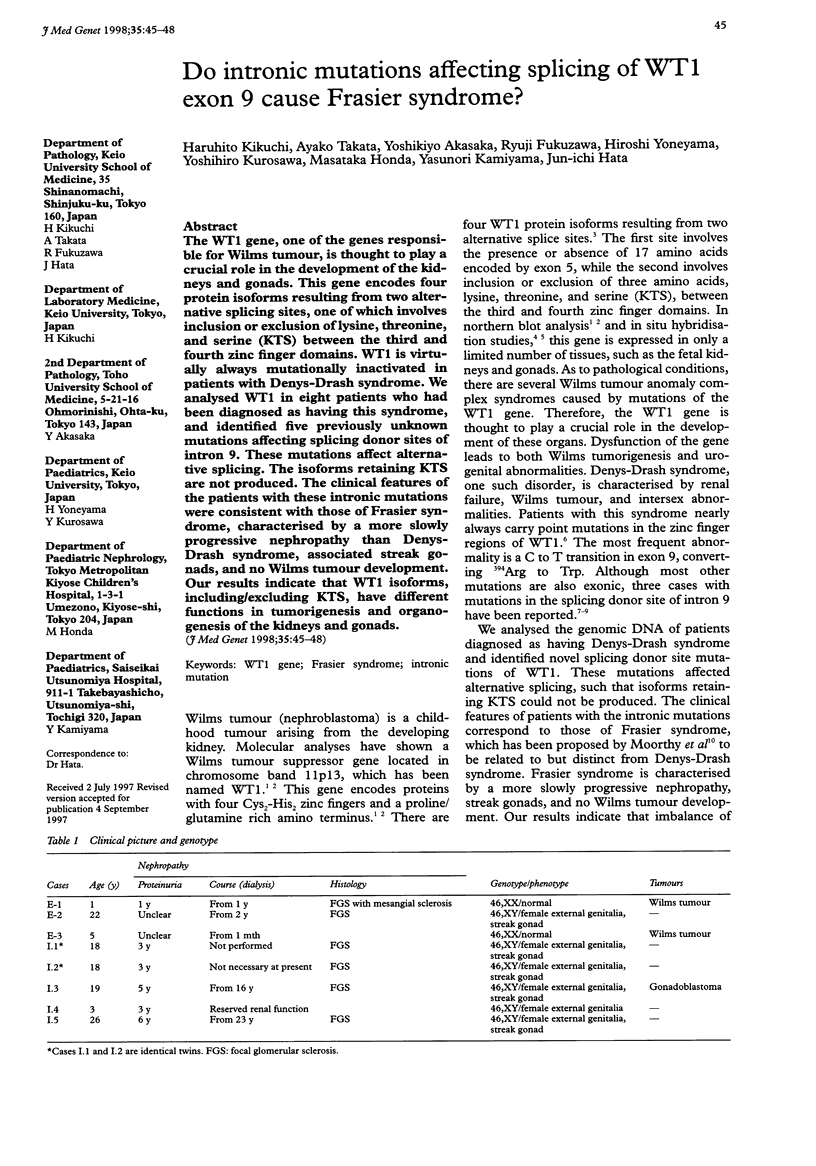
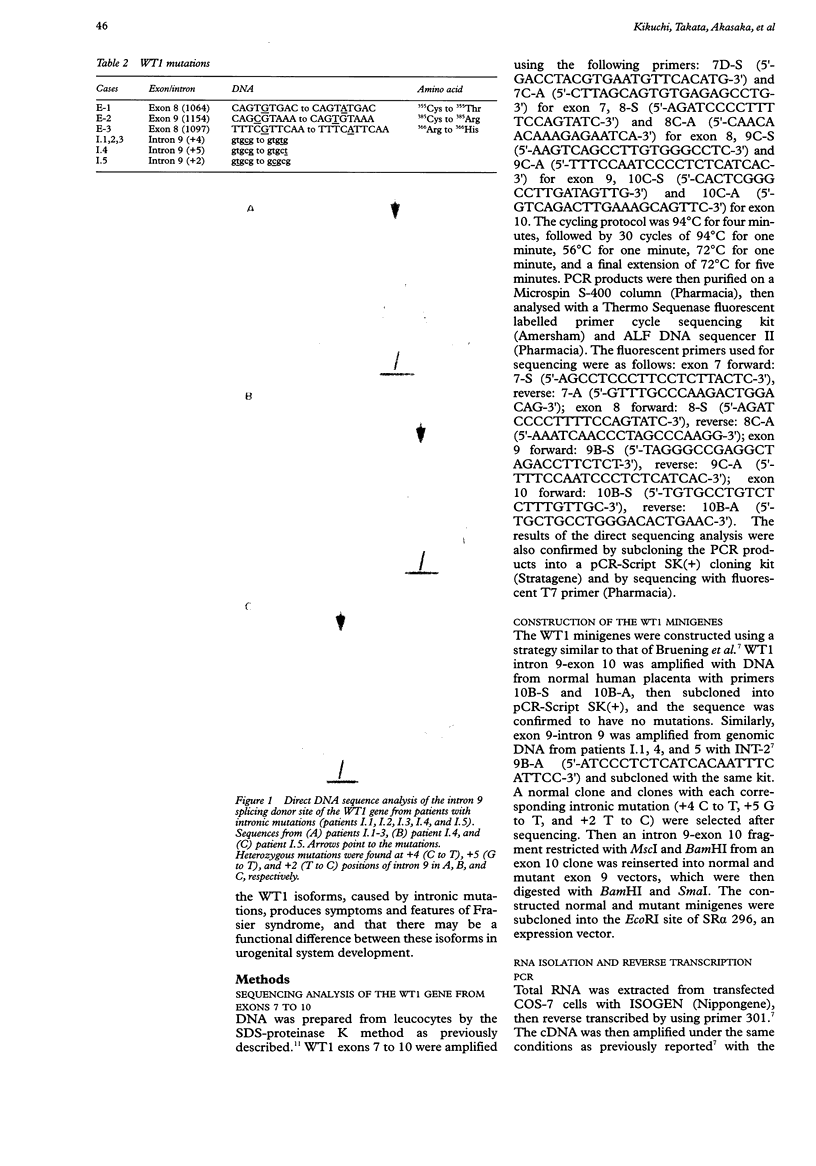
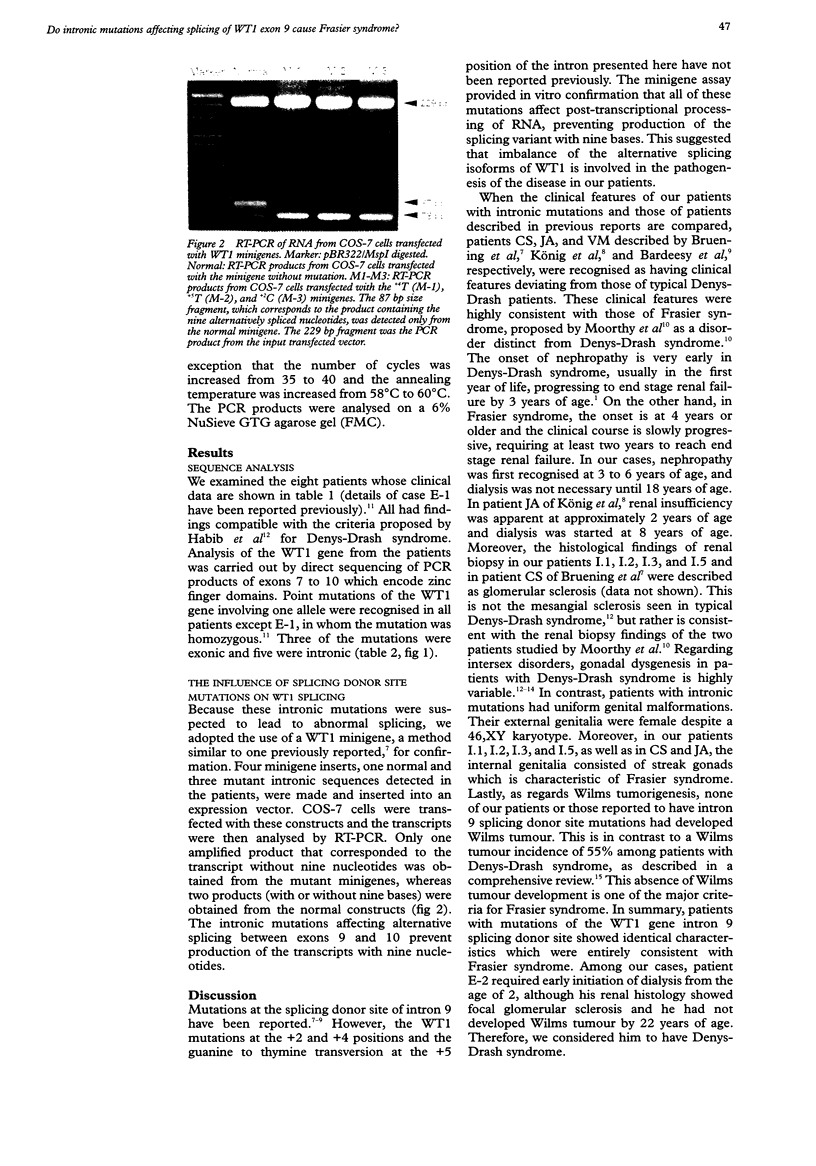
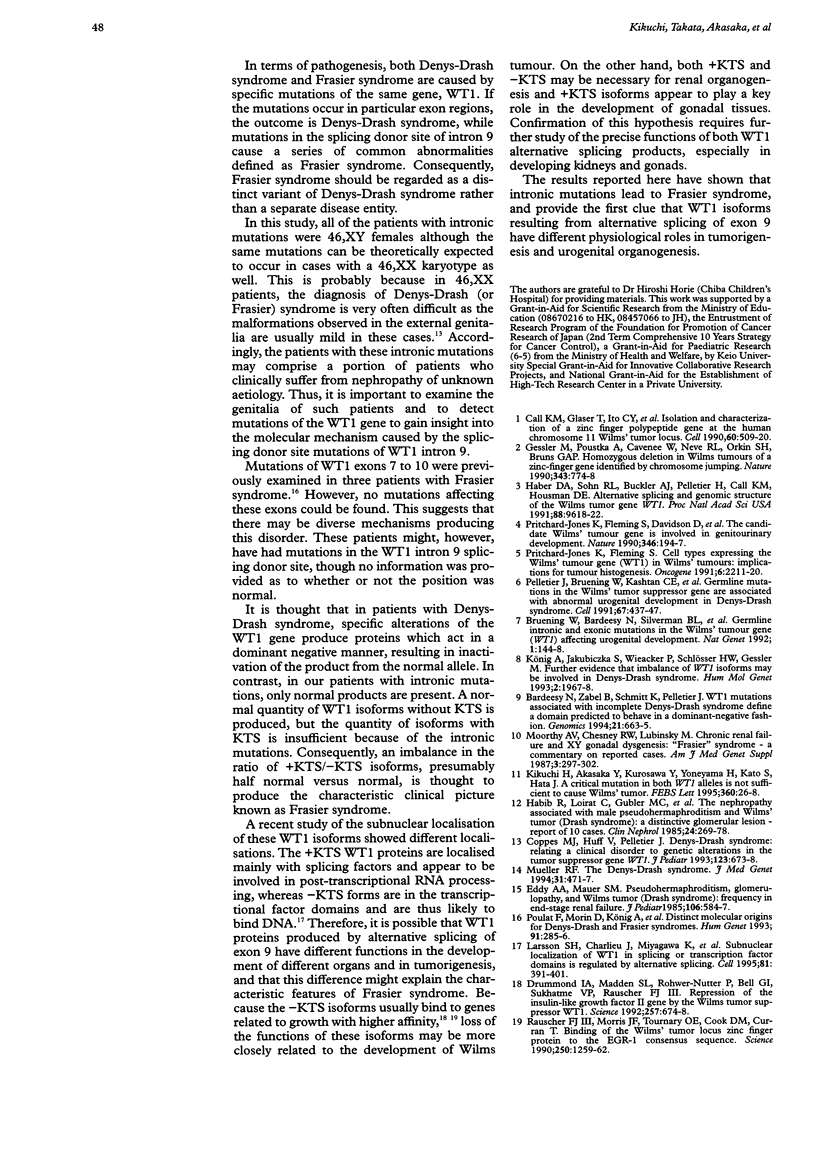
Images in this article
Selected References
These references are in PubMed. This may not be the complete list of references from this article.
- Bardeesy N., Zabel B., Schmitt K., Pelletier J. WT1 mutations associated with incomplete Denys-Drash syndrome define a domain predicted to behave in a dominant-negative fashion. Genomics. 1994 Jun;21(3):663–664. doi: 10.1006/geno.1994.1333. [DOI] [PubMed] [Google Scholar]
- Bruening W., Bardeesy N., Silverman B. L., Cohn R. A., Machin G. A., Aronson A. J., Housman D., Pelletier J. Germline intronic and exonic mutations in the Wilms' tumour gene (WT1) affecting urogenital development. Nat Genet. 1992 May;1(2):144–148. doi: 10.1038/ng0592-144. [DOI] [PubMed] [Google Scholar]
- Call K. M., Glaser T., Ito C. Y., Buckler A. J., Pelletier J., Haber D. A., Rose E. A., Kral A., Yeger H., Lewis W. H. Isolation and characterization of a zinc finger polypeptide gene at the human chromosome 11 Wilms' tumor locus. Cell. 1990 Feb 9;60(3):509–520. doi: 10.1016/0092-8674(90)90601-a. [DOI] [PubMed] [Google Scholar]
- Coppes M. J., Huff V., Pelletier J. Denys-Drash syndrome: relating a clinical disorder to genetic alterations in the tumor suppressor gene WT1. J Pediatr. 1993 Nov;123(5):673–678. doi: 10.1016/s0022-3476(05)80839-x. [DOI] [PubMed] [Google Scholar]
- Drummond I. A., Madden S. L., Rohwer-Nutter P., Bell G. I., Sukhatme V. P., Rauscher F. J., 3rd Repression of the insulin-like growth factor II gene by the Wilms tumor suppressor WT1. Science. 1992 Jul 31;257(5070):674–678. doi: 10.1126/science.1323141. [DOI] [PubMed] [Google Scholar]
- Gessler M., Poustka A., Cavenee W., Neve R. L., Orkin S. H., Bruns G. A. Homozygous deletion in Wilms tumours of a zinc-finger gene identified by chromosome jumping. Nature. 1990 Feb 22;343(6260):774–778. doi: 10.1038/343774a0. [DOI] [PubMed] [Google Scholar]
- Haber D. A., Sohn R. L., Buckler A. J., Pelletier J., Call K. M., Housman D. E. Alternative splicing and genomic structure of the Wilms tumor gene WT1. Proc Natl Acad Sci U S A. 1991 Nov 1;88(21):9618–9622. doi: 10.1073/pnas.88.21.9618. [DOI] [PMC free article] [PubMed] [Google Scholar]
- Habib R., Loirat C., Gubler M. C., Niaudet P., Bensman A., Levy M., Broyer M. The nephropathy associated with male pseudohermaphroditism and Wilms' tumor (Drash syndrome): a distinctive glomerular lesion--report of 10 cases. Clin Nephrol. 1985 Dec;24(6):269–278. [PubMed] [Google Scholar]
- Kikuchi H., Akasaka Y., Kurosawa Y., Yoneyama H., Kato S., Hata J. A critical mutation in both WT1 alleles is not sufficient to cause Wilms' tumor. FEBS Lett. 1995 Feb 20;360(1):26–28. doi: 10.1016/0014-5793(95)00071-g. [DOI] [PubMed] [Google Scholar]
- König A., Jakubiczka S., Wieacker P., Schlösser H. W., Gessler M. Further evidence that imbalance of WT1 isoforms may be involved in Denys-Drash syndrome. Hum Mol Genet. 1993 Nov;2(11):1967–1968. doi: 10.1093/hmg/2.11.1967. [DOI] [PubMed] [Google Scholar]
- Larsson S. H., Charlieu J. P., Miyagawa K., Engelkamp D., Rassoulzadegan M., Ross A., Cuzin F., van Heyningen V., Hastie N. D. Subnuclear localization of WT1 in splicing or transcription factor domains is regulated by alternative splicing. Cell. 1995 May 5;81(3):391–401. doi: 10.1016/0092-8674(95)90392-5. [DOI] [PubMed] [Google Scholar]
- Moorthy A. V., Chesney R. W., Lubinsky M. Chronic renal failure and XY gonadal dysgenesis: "Frasier" syndrome--a commentary on reported cases. Am J Med Genet Suppl. 1987;3:297–302. doi: 10.1002/ajmg.1320280535. [DOI] [PubMed] [Google Scholar]
- Mueller R. F. The Denys-Drash syndrome. J Med Genet. 1994 Jun;31(6):471–477. doi: 10.1136/jmg.31.6.471. [DOI] [PMC free article] [PubMed] [Google Scholar]
- Pelletier J., Bruening W., Kashtan C. E., Mauer S. M., Manivel J. C., Striegel J. E., Houghton D. C., Junien C., Habib R., Fouser L. Germline mutations in the Wilms' tumor suppressor gene are associated with abnormal urogenital development in Denys-Drash syndrome. Cell. 1991 Oct 18;67(2):437–447. doi: 10.1016/0092-8674(91)90194-4. [DOI] [PubMed] [Google Scholar]
- Poulat F., Morin D., König A., Brun P., Giltay J., Sultan C., Dumas R., Gessler M., Berta P. Distinct molecular origins for Denys-Drash and Frasier syndromes. Hum Genet. 1993 Apr;91(3):285–286. doi: 10.1007/BF00218274. [DOI] [PubMed] [Google Scholar]
- Pritchard-Jones K., Fleming S. Cell types expressing the Wilms' tumour gene (WT1) in Wilms' tumours: implications for tumour histogenesis. Oncogene. 1991 Dec;6(12):2211–2220. [PubMed] [Google Scholar]
- Pritchard-Jones K., Fleming S., Davidson D., Bickmore W., Porteous D., Gosden C., Bard J., Buckler A., Pelletier J., Housman D. The candidate Wilms' tumour gene is involved in genitourinary development. Nature. 1990 Jul 12;346(6280):194–197. doi: 10.1038/346194a0. [DOI] [PubMed] [Google Scholar]
- Rauscher F. J., 3rd, Morris J. F., Tournay O. E., Cook D. M., Curran T. Binding of the Wilms' tumor locus zinc finger protein to the EGR-1 consensus sequence. Science. 1990 Nov 30;250(4985):1259–1262. doi: 10.1126/science.2244209. [DOI] [PubMed] [Google Scholar]



